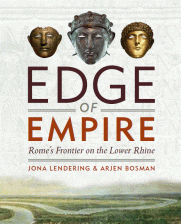I already blogged about Sodom and Gomorah: people are looking for it at the bottom of the Dead Sea, although the Bible is quite explicit that the remains were visible on the land (Zephaniah 2.9). When you write about Antiquity, the sources are the thing you can ignore, of course.
Or, if you have actually read the sources and haven’t found what you need, you just invent it: Archimedes’ Heat Ray, Herodotus’ visit to Babylon, or Octavian calling himself Octavian – just three examples of things not mentioned in our sources, reproduced by professional historians, employed by universities. Sources are only there to be either ignored or expanded with the stuff you need.
Alan Bond and Mark Hempsell of Bristol University are exceptional, because they are capable of making both mistakes simultaneously, if I am to believe this article. They have written a book called A Sumerian Observation of the Köfels’ Impact Event, in which they argue that a cuneiform tablet now in the British Museum contains a description of a Sumerian observation of a very large meteor – actually an asteroid over a kilometre in diameter – that impacted a place in Austria called Köfels. They can date it to June 29, 3123 BCE.
So far, so good. I wonder if there were Sumerian astronomical records that long ago, but for argument’s sake, I assume they are right. Now if the article I linked to refers to their own words, they also assume that a piece of this meteor destroyed Sodom and Gomorrah. Unfortunately, the Bible refers to a terrible shower, and does not mention anything similar to a meteor:
Then the Lord rained upon Sodom and upon Gomorrah brimstone and fire from the Lord out of heaven (Genesis 19.24).
In other words, Bond and Hempsell are adding something to their source that simply isn’t there. It’s the same approach of texts that I discussed here: if an ancient text says that the Nile has converted into blood, you think “blood is red”, and because algae can be red too, you read the Biblical account as a description of algae. A meteor is destructive and falls out of heaven; the rain of the Lord is destructive and falls out of heaven; hence, a meteor is the rain of the lord. Textbook examples of the fallacy of the undistributed middle.
But even when we accept that Genesis describes a meteor impact, there remains another problem. Bond and Hempsell have decided to accept the story in Genesis as sufficiently trustworthy to be studied. So, why don’t they accept the chronology of Genesis as well? Even if we accept the longlevity of the Biblical patriarchs, there is no way to date the destruction of Sodom and Gomorrah prior to the twenty-first century BCE.
Bond and Hempsell want to have it both ways: they want to accept the Biblical story about the destruction of the cities, but don’t want to accept the dates implied in the Bible. That is possible. Historical criticism is intended to help you establish why you can use which parts of the same text, and why some parts are more reliable than others. And fortunately, historians have been looking at the stories of the Abraham cycle. Although the consensus is not uncontested, many scholars will date Abraham to the Middle Bronze Age, let’s say in the seventeenth century. Again, this cannot be combined with a meteor impact in late fourth millennium. (I won’t discuss the theory – very likely, in my view – that the Abraham cycle is not historical at all.)
Bond and Hempsell ought to have stuck to reading the tablet itself. Their proposal is sufficiently interesting. As it now stands, they are adding a meteor to the Bible that is not mentioned and ignore a chronology that is. I hope that the journalist of the article I linked to, messed up things, but I am not sure.


 Subscribe to feed
Subscribe to feed
I don’t know these guys, but they had a show on History Channel based on this theory. (Must be nice, eh?) Anyway, their idea was that the meteor burst apart in the air, which partially chonked into this mountain up in the Alps and partially split into a gazillion other pieces. The gazillion other pieces showered across a large area, mostly falling in uninhabited areas but a lot showering on the various Dead Sea cities; superheating of the rocks set the cities on fire. There was computer animation slanted toward making it look like a rain of fire and brimstone. Thus the shower.
It’s the lack of sulfur that worries me. Brimstone is kinda easy to identify and hard to confuse.
Findings of meteor showers or the chronological order of events helps debunk this story but I think the main argument to the fallacy of Sodom and Gomorrah is in it’s name. Aramaic and Hebrew language experts note that Sodom roughly translates to rubble and Gomorrah translates to scorched earth (I may have these round the wrong way, so apologies if so). You could argue that they were named after the desolate lands they were built on, but history shows city names were often more positive, i.e Jerusalem = city of peace. Also it seems too ironic that these cities that no one can actually locate, happened to be named after what befell them. It would be like someone naming their child leukemia, then said child contracting that disease.
The heating caused by the meteor is a plausible reason for the destruction — compare the intense heating caused by the recent, verified Russian fireball. The references to sulphur and brimstone could simply be the only ones the writers had to explain the extreme temperatures involved.
As for the place names, since Genesis is supposed to have been written much later than the meteor, possibly the Genesis story is an explanation of the devastated sites, or traditions based on them, rather than recently destroyed active cities.